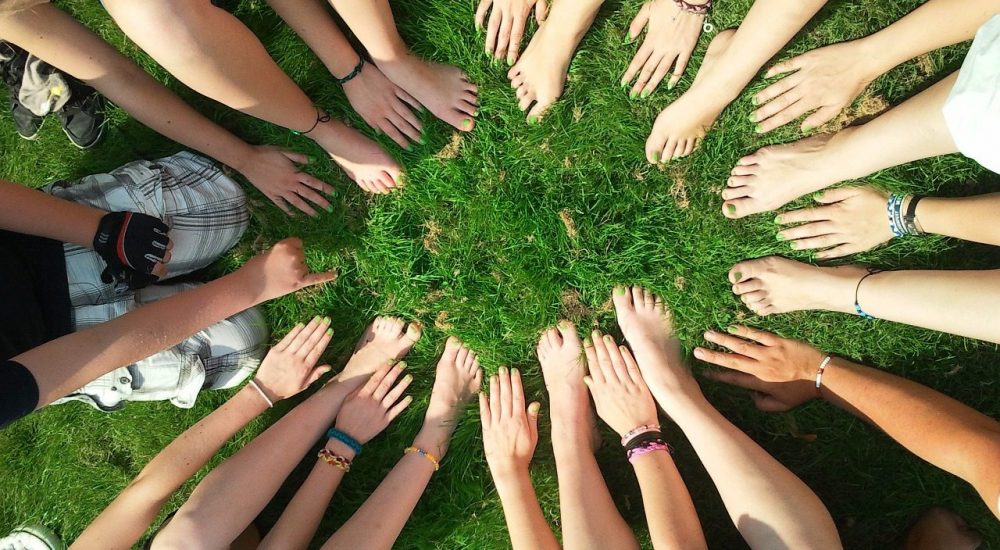Being the last one picked is just no fun. What if the last words you heard before you became a team member was “Alright, I guess we have to take you”? The first play hasn’t been made and already, you feel like a failure. For some students, the mere act of picking teams is so difficult they simply choose not to participate in physical activity, thus avoiding the stress. The emotional safety of our students is as essential as the physical safety and it can begin with the act of picking teams painlessly. I recommend the use of a two-step approach: 1) Form small groups, and then 2) break them into teams.
Step One: Forming Small Groups
1. Play a grouping game. One that is very effective is “The Captain is Coming.”
The Captain is Coming
(Modified from and used with permission Teambuilding Odysseys- Odyssey Teams, Chico-CA)
Purpose: This is a great game to get team members working together in order to accomplish a specific series of tasks. They will need to get out of their regular group of friends to stay in the game. This will really help get students mixing and laughing.
Set Up:
* You are the Captain of a pirate ship. Teach all your team members the series of motions. Show them one motion and then have everyone model it back to you. You are the Captain. Arrgh!
* One person for swab the deck. (pretend to mop the floor)
* If the Captain says “The Captain is Coming” All members are to freeze and stand at attention.
* Two for all hands on deck (two people connect hands above their heads).
* Three people for person over board (two people link arms like an life preserver and the third stands in the middle).
* Four people for man the lifeboats (form a life boat, two in front, two in back and do rowing motions).
* Five people for grub time (four act as if you are grubbing from a plate around one person as the table).
* The captain calls any of the commands and the team members scramble into groups and act out the motion called.
* The words The Captain is Coming can be used at any time to get the groups to stand quietly and salute.
2. Grouping Ideas. The must be several hundred ways to group students. Here a just a few:
* Number of letters in their first or last name.
* Playing Cards- each student gets a card and then groups by suit or value.
* Whistle Blows- Students move around, honoring personal space. Whistle blows indicate the number in each group.
* Musical Groups- Like musical chairs, only when the music stops students form groups of the number indicated by the number of fingers the leader holds up.
* Birth Months, length of hair, tallest to shortest, shoe size, etc. are all good ways to get students to group.
* Form A Band. Each band must have a drummer, guitar player, keyboard player and singer. Then they mime out their band, complete with air instrumentation.
* Form A Sports Team- pitchers, catchers, hitters, outfielders and hot dog salespeople.
* Hair Bands on Wrists- They fit perfectly and can be easily reused. Give each student a band and form teams based on color.
3. Use “incorporations.” An “incorporation” is a small group of students that are grouped by something in common and are given the name of an object. Using only the members of their group they are to create that object.Examples:
A) You need a group of 4, who were born in the same month, and you are to create a washing machine.
B) You need a group of three, who have the same last digit in their phone number, and you are to create an elephant.
C) You need a group of 5, who use the same flavor toothpaste, and you are to form a pentagon. Have your students create new incorporations with different commonalities and objects. They will see how many things they really do have in common and how easy it is to work together.
Step Two- Forming Teams from Small Groups
Now comes the fun part. The games are used to break students into small groups by using various commands or incorporations. Once you have the small groups created, have one member from each group raise their hand and then move to another place in the play space. Then do the same with each remaining member. A small group of two would then create two teams, a group of three, three teams and so on. The same technique can work when the small groups have different members, like Form a Band. Here all the drummers go to one group, all the singers to another, etc.
Why does this work?
These methods eliminate “partner picking” and “clicks”. Students are grouped and ungrouped so often, they begin to worry less about who is in their group and more on completing the task. No one is the last one picked and everyone gets equal chance to participate.
You will still have those students who are “:joined at the hip” of their best friend, however, the more these types of activities are used, the less that becomes a problem. Students come to know and work better with other members of the group they would not ordinarily interact with.
Remember- Every minute a student feels success in participating in physical activities helps to build a positive, lifetime attitude towards fitness. Every minute they spend in your program is a “teachable moment” and that includes the time spent picking teams. Let’s make every minute count!
Author Profile: @gkgorke
